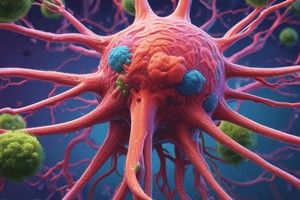Podcast
Questions and Answers
Which type of lymphatic vessel accompanies superficial veins?
Which type of lymphatic vessel accompanies superficial veins?
- Lymphatic ducts
- Superficial vessels (correct)
- Lymphatic trunks
- Deep vessels
Which of the following is a primary lymphatic organ?
Which of the following is a primary lymphatic organ?
- Spleen
- Lymph nodes
- Thymus gland (correct)
- Lymph nodules
What is the primary function of the right lymphatic duct?
What is the primary function of the right lymphatic duct?
- Drains the right side of the head, neck, right arm, and right thorax (correct)
- Drains the left side of the head and upper body
- Drains the entire body except the lower limbs
- Drains lymph from the intestines
What type of lymphatic tissue is characterized by having no capsule and found in almost all organs?
What type of lymphatic tissue is characterized by having no capsule and found in almost all organs?
Which lymphatic cells are considered part of the immune response?
Which lymphatic cells are considered part of the immune response?
Which of the following is NOT a function of the lymphatic system?
Which of the following is NOT a function of the lymphatic system?
What is the primary fluid collected by lymphatic capillaries?
What is the primary fluid collected by lymphatic capillaries?
Where are lacteals primarily found?
Where are lacteals primarily found?
Which type of lymphatic organ is responsible for the maturation of T lymphocytes?
Which type of lymphatic organ is responsible for the maturation of T lymphocytes?
What is the main characteristic of lymphatic vessels compared to blood vessels?
What is the main characteristic of lymphatic vessels compared to blood vessels?
Which of the following lymphatic structures is involved in filtering lymph?
Which of the following lymphatic structures is involved in filtering lymph?
Which type of lymphatic organ plays a role in the immune response by producing antibodies?
Which type of lymphatic organ plays a role in the immune response by producing antibodies?
What indicates the presence of dietary lipids in lymph collected from the small intestine?
What indicates the presence of dietary lipids in lymph collected from the small intestine?
Flashcards are hidden until you start studying
Study Notes
Lymphatic System Components & Functions
-
Consists of:
- Lymphatic capillaries
- Lymphatic vessels
- Large lymphatic ducts
- Lymph nodes
- Lymphatic organs
-
Functions:
- Returns tissue fluid to the bloodstream
- Transports fats from the digestive tract to the bloodstream
- Plays a crucial role in the body's defense and surveillance mechanisms
Lymph Fluid
- Similar to blood plasma
- Filters out of blood
- Contains no erythrocytes or platelets
- Less proteins compared to blood plasma
- Contains more leukocytes
Lymphatic Vessels
- Capillaries: Highly permeable, collect excess tissue fluid; widespread in the body, absent in bone, teeth, and the central nervous system
- Thin-walled and lined with endothelium
- Form plexuses (networks)
- Unite to form larger lymph vessels
- Lacteals: Special type of lymphatic capillary present in the small intestine, responsible for absorbing interstitial fluid, dietary lipids, and lipid-soluble vitamins
- Lymph in this area has a milky color due to lipid content and is called chyle
- Lymphatic Vessels: Lymphatic capillaries join to form lymphatic vessels (lymphatics)
- Provide an alternate pathway for tissue fluid return to the veins
- Have thinner walls compared to veins of a similar size
- Transparent and contain numerous valves
Lymphatic Ducts
- Two Main Ducts:
- Right Lymphatic Duct: Drains the right side of the head and neck, right arm, and right thorax; empties into the right subclavian vein.
- Thoracic Duct: Drains the rest of the body; empties into the left subclavian vein.
- Lymphatic Vessels Arrangement:
- Superficial Vessels: Drain superficial tissues and accompany superficial veins
- Deep Vessels: Drain deep tissues and accompany deep blood vessels
- Lymphatic Trunks: Lymphatics join to form larger vessels known as lymphatic trunks
- Six Main Lymphatic Trunks:
- Right and left jugular trunks
- Right and left subclavian trunks
- Right and left bronchomediastinal trunks
- Right and left lumbar trunks
- Intestinal trunk
- Six Main Lymphatic Trunks:
Lymphatic Cells
- Also known as lymphoid cells
- Located in both the lymphatic system and cardiovascular system
- Contribute to immune responses
- Types:
- Macrophages
- Epithelial cells
- Dendritic cells
- Lymphocytes
Lymphatic Organs
- Primary Lymphatic Organs:
- Red bone marrow
- Thymus gland
- Secondary Lymphatic Organs:
- Lymph nodes
- Lymph nodules
- Spleen
- Tonsils
Lymph Tissue
- Three Types:
- Diffuse Lymphatic Tissue: No capsule present; Located in connective tissues of almost all organs
- Lymphatic Nodules: No capsule present; Oval-shaped masses; Found singly or in clusters
- Lymphatic Organs: Possess capsules and consist of lymph nodes, spleen, thymus gland, and tonsils
Studying That Suits You
Use AI to generate personalized quizzes and flashcards to suit your learning preferences.


